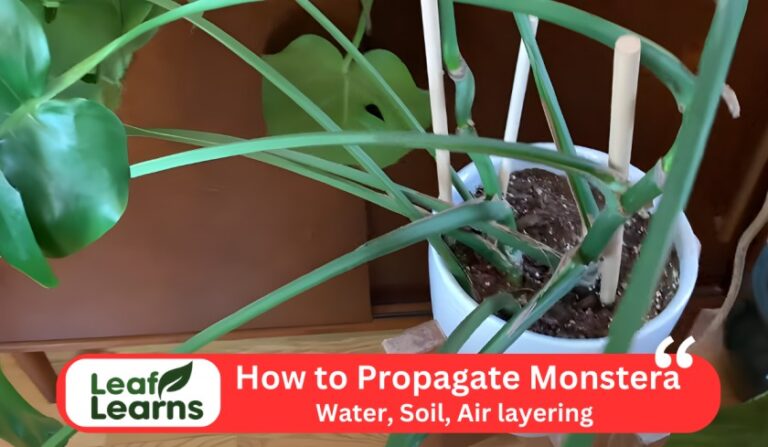How to save overwatered coleus – Leaflearns (2024)
To save an overwatered coleus, first you should stop watering and check for root rot. Look at the plant to see if it is damp, then remove any mushy roots using sterilized scissors. Next, reduce the frequency of watering, allowing the soil to dry out, and make sure that excess water can drain with the help of drainage holes in the planter and a well draining soil.

In addition, maintain plant properly by watering if the soil is dry, giving bright indirect sun, and occasionally feeding it. Check regularly on the plant to regulate the moisture level that will be needed; this is to ensure that the plant is in good health.
Overwatered coleus plants, with their vibrant foliage and easy care requirements, are popular choices for gardens and indoor spaces. On the other hand, watering too much can equate to sickness and it will lead them to poor. Although targeted watering patterns are essential in ensuring your coleus plants are in the best state, knowing when to do so is equally of the essence.
Contents
- 1 Symptoms of an Overwatered Coleus
- 2 Understanding Bacterial Problems in Overwater Coleus
- 3 How Does Overwatering a Coleus Occur?
- 4 How to Identify if Your Coleus is Overwatered?
- 5 Saving an Overwatered Coleus – Step by Step
- 6 How to Save an Overwatered Coleus Plant
- 7 How to Prevent Overwatering a Coleus Plant
- 8 How Often Should You Actually Water a Coleus Plant?
- 9 Using Preventative Fungicides
- 10 Importance of Recognizing Overwatered Coleus Symptoms
- 11 Enchanting Escapes: Exploring Overwater Bungalows and Villas
- 12 Conclusion
- 13 FAQs
Symptoms of an Overwatered Coleus
Fungal Pathogens: Root rot and powdery mildew are caused by fungal pathogens that flourish in an environment that is conducive to their growth, which is created by overwatering.
Excessive wetness suffocates the roots and impairs their capacity to absorb nutrients, causing the leaves to become yellow or brown.
Wilting Leaves: Inversely, excessive watering can lead to wilting leaves since it damages roots and reduces their ability to absorb oxygen.
Mushy Stem: An overwater coleus may develop a mushy stem, which is a sign of tissue deterioration.
No New Growth: As the plant fights to recover from stress, stunted growth or a lack of new growth is a frequent indicator of overwatering.
Understanding Bacterial Problems in Overwater Coleus
Bacterial infections often accompany overwatering, further compromising the plant’s health. Symptoms include leaf spots, wilting, and a foul odor emanating from the soil.
How Does Overwatering a Coleus Occur?
Several factors contribute to overwatering:
- Frequency: Watering too often without letting the ground dry out in between applications.
- Poor Drainage: Soil that is too wet in pots or planting beds might result from inadequate drainage.
- Inappropriate Soil: Overly wet soil makes problems with overwatering worse.
- Environmental Factors: Soil moisture levels might rise over what coleus plants can withstand due to humid weather or heavy rains.

How to Identify if Your Coleus is Overwatered?
Examine the Soil: Soggy soil that holds moisture for extended periods of time is a sign of overwatering.
Verify the Drainage: Make sure water can exit pots easily and that they have drainage holes.
Examine the condition of the leaves: Look for browning or yellowing, and especially if the leaves feel mushy or floppy.
Consider Stem Health: Squeeze the stem gently; if it feels spongy or soft, overwatering can be the cause.
Keep an eye on growth: If a plant is not producing new growth or is developing slowly, it may be suffering from too much moisture.
Saving an Overwatered Coleus – Step by Step
Remove from Soil
The overwater coleus should be carefully removed from its container so as not to further harm the roots. Shake off any extra dirt gently so that the root ball is visible.
Wash the Root Ball
Gently cleanse the root ball of any leftover dirt with lukewarm water. This aids in getting rid of extra moisture and stops more decay.
Remove Affected Leaves, Stems, and Roots
Examine the plant for evidence of decay or overwatering damage. Trim any mushy or discoloured leaves, stems, and roots with pruning shears or clean, sharp scissors. This will lessen the chance of illness spreading and encourage new development.
Treat with Fungicide
Apply a good fungicide to the coleus to avoid fungal diseases, which frequently accompany overwatering. Apply the fungicide to the remaining foliage and soil, paying close attention to the manufacturer’s recommendations.
Repot
Pick a spotless container with the right amount of drainage holes, then add well-draining potting mix to it.
Make sure the root ball is at the same level as before when you gently plant the coleus in the new container. To secure the plant, fill in any spaces with more potting mix and gently push down.

How to Save an Overwatered Coleus Plant
Let’s go a little further into the previously mentioned procedures and examine some more advice for effectively recovering your overwater coleus.
Make sure the plant gets enough sunshine, but try not to put it in direct sunlight right away after repotting as this can stress it out even more.
To avoid overwatering in the future, keep a close eye on the moisture content of the soil and modify your watering schedule as necessary.
How to Prevent Overwatering a Coleus Plant
Maintaining the health and growth of your coleus plants requires prevention. Always check the moisture content of the soil before watering, and let the top inch of soil dry out in between applications to prevent overwatering.
To keep water from building up around the roots, use well-draining potting mix and containers with drainage holes.
How Often Should You Actually Water a Coleus Plant?
Watering frequency is influenced by a number of variables, including the size of the plant, the surrounding environment, and the potting mix.
Water your coleus when the top inch of soil feels dry to the touch, as a general rule of thumb. Instead of watering on a set timetable, adjust your watering schedule based on the demands of the plant.
Using Preventative Fungicides
Coleus plants can benefit greatly from the use of preventative fungicides to shield them against fungal diseases brought on by excessive watering.
By forming a barrier on the leaf of the plant, these compounds prevent the growth of dangerous fungus. Apply the fungicide as directed on the label, paying particular attention to times when there is a lot of humidity or precipitation.
Importance of Recognizing Overwatered Coleus Symptoms
In the realm of gardening, understanding the signs of overwatered coleus is crucial for their thriving care. When deciphering if a coleus is overwatered, watch for telltale symptoms like droopy leaves, wilting, or a general decline in vibrancy.
Overwater coleus may exhibit behavior such as stunted growth or yellowing leaves, signaling distress from too much moisture. It’s essential to implement proper overwater coleus care promptly, adjusting watering frequency and ensuring proper drainage to rescue the plant from further deterioration.
Techniques like transplanting to well-draining soil or reducing watering frequency can help save overwater coleus, restoring them to their lush, vibrant state.
Enchanting Escapes: Exploring Overwater Bungalows and Villas
On a different note, the allure of overwater bungalows and villas beckons travelers seeking serene aquatic escapes. Destinations like Bali, the Maldives, or Greece boast picturesque overwater bungalows that offer unparalleled luxury and relaxation.
Whether nestled above crystal-clear lagoons or perched along pristine coastlines, these overwater havens provide an idyllic retreat for indulging in panoramic views and aquatic adventures.
From the turquoise waters of the Caribbean to the charming landscapes of Crete, overwater bungalows and villas promise unforgettable experiences, making them sought-after destinations for discerning travelers seeking a slice of paradise.
Conclusion
Ultimately, the key to maintaining the health and vigor of your coleus plants is to identify and treat overwatering problems as soon as possible.
Fungal diseases, yellowing leaves, and wilting are examples of symptoms that suggest concern and call for quick attention.
You may successfully resurrect these hardy plants by taking a methodical approach to saving overwater coleus, which includes cautious repotting, removing damaged sections, and using fungicides.
FAQs
How do you save an overwatered Coleus?
Remove the overwater Coleus from the ground, clean the root ball, and cut off any damaged sections before attempting to salvage it. To avoid overwatering in the future, treat with fungicide, repot in well-draining soil, and modify watering schedules.
How do you know if your Coleus has root rot?
Wilting leaves, yellowing or browning foliage, mushy stems, and an unpleasant smell coming from the soil are all indications of root rot in Coleus. Examining the roots may show sections that are mushy, slimy, or black, all of which point to rotting.
Can Coleus get too much water?
Indeed, overwatering may cause problems for Coleus plants, including wilting, fungal infections, and root rot. To avoid this, proper drainage and frequency adjustments for watering are crucial.
Do Coleus like wet leaves?
No, while moist foliage can encourage fungal illnesses like powdery mildew, coleus typically prefers dry leaves. Maintaining dry and healthy leaves requires watering the plant from the base up and avoiding overhead irrigation.
How do I know if my coleus is overwatered?
Symptoms like drooping leaves, yellowing or browning foliage, mushy stems, stunted development, or a lack of new growth will help you recognize an overwater Coleus. Furthermore, the soil might be too damp for extended periods.






